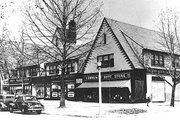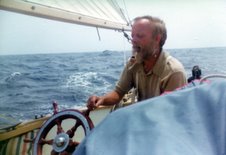In Dundalk there was an airport, Logan Field, that had been a military airport during World War One. It was a place where many Sunday afternoons were spent watching airplanes take off and land. The military training planes were busy seven days a week. They were painted blue and yellow and stood out from the commercial and private planes that set all around the field. It was here that my Father put me on a Ford Tri-motor passenger plane for a tour around Baltimore for about 20 minutes. He would not put out the two dollars it would have cost for himself to go, but they had a couple empty seats and the Pilot let me go for a quarter. Two dollars was a lot of money.
The field was too small for the new airliners that were now in service and these new DC 3 airliners were struggling to take off and to clear the nearby houses that were encroaching on its glide path and at the end of the runways.
There was a terminal where the China Clippers were landing in the Baltimore harbor. These huge seaplanes were carrying passengers back and fourth from South America, the Caribbean and Florida. Baltimore thought this was the future of air travel, and so, the city decided to build an airport in the harbor where DC3's could land as well as seaplanes. Kimmel's Mountain was the place to get the dirt to fill a section of the harbor for the airport. Kimmel's Mountain was a beautiful place. It was a huge stand of hardwood trees--oak, ash, gum and other trees with different nut bearing trees in the mix. Around its edges it had grown up in blackberries and raspberries, as well as strawberries and goose berries with an occasional wild cherry tree. During the summer, some of the local families would search there for the variety of berries and nuts. By Christmas every dining table in every house was filled with nuts. Paths criss-crossed through the woods and were a favorite place for family walks. The only danger there was that of walking up on unaware lovers. In the early 1930's they began digging up the hill and hauling it away by the dump truck load. They started on the other side of the hill from our house and for years they dug away at the hill. Early on, there were three huge shovels and maybe fifty dump trucks working. After awhile they were down to one really huge shovel. It was a true steam shovel with a shovel so big a full grown man could stand up inside of it. Two of its shovels would fill the biggest Mack "chain-drive" dump truck they had. The sight of that huge shovel digging only about a hundred and fifty yards a way was kind of frightening. I remember my sister Madge saying it scared her and how she hated that thing. It was kind of like a huge earth eating monster chomping ever closer day by day and there was no stopping it.
Steam shovels and dump trucks were all that filled mine and the other kids minds at that time. I got my bottom switched several times for sneaking away to go up and watch that shovel work. We all played steam shovel as small kids. We would squat down and use a tin can while pretending we were steam shovels digging in the dirt and making steam shovel noises all the while. A large coffee can, because of its size, could be traded for a cap pistol any time. We dug a hole at least 10 feet in diameter and 5 feet deep. We covered it up with a wooden roof a rug and a layer of dirt. My dog used it for a dog house, as it was warm in the winter and cool in the summer. On a hot day it was hard to get him to come out.
Kimmel's Mountain was actually a sand dune that had been left there about a hundred thousand years before when the Atlantic coast was along that area. In March or during a good thunderstorm the wind would pick up clouds of sand and blow them all over the neighborhood. I remember Mom stuffing rags under the door once in a storm. The front porch had an inch of sand on it and everything in the house a layer of dust.








